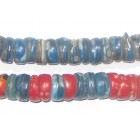
The journey of a bead collector is one filled with ponderings and questions. Where do my Trade Beads come from? Who made them? Even if these tiny details don’t mean much to you personally, they can have significant bearing upon your authority and commercial appeal as a jewelry artist.
Kakamba Prosser Beads are one of my most recent discoveries. I actually happened upon them whilst looking for some colorful spacers to use in my jewelry. Early Prosser Beads were named after English brothers Richard and Thomas Prosser, who devised the innovative molding technique for their production in 1840. The rights for this technique were later bought by Jean-Felix Bapterosses, a French button manufacturer who would later found one of the largest bead-producing factories in Europe. Sometime in the 1860s, Prosser Beads came to be known as “Kakamba Prosser Beads”; named after a small town in The Republic of the Congo where they were traded by merchants.
According to trade records, Africa was one of the chief markets for Prosser Beads. European traders would use them to build rapports with tribal chiefs, thus ensuring safe passage through unexplored or unknown regions. However, these merchants were shrewd types, and weren’t averse to conning tribespeople in order to get what they wanted. Beads were often strung upon weak cord, which would break easily. Natives were also told it was bad luck to pick them up, thus creating a need for new beads in exchange for small favors.
Prosser Beads continued to be produced in Europe long after the death of Jean-Felix Bapterosses in 1885, however, largely fell out of favor as more elaborate beads were introduced to Africa in the early 1900s. Their sad decline in popularity eventually relegated them to the history books by the mid 20th Century – until locals in Kakamba began finding hoards of them in the ground while farming.
To think that the beads I hold today once traveled 3,000 miles from Europe to the Congo is amazing, but more fascinating still is the fact they may once have adorned the neck of a great tribal chief all those years ago. A slice of history being recycled once more for self adornment!